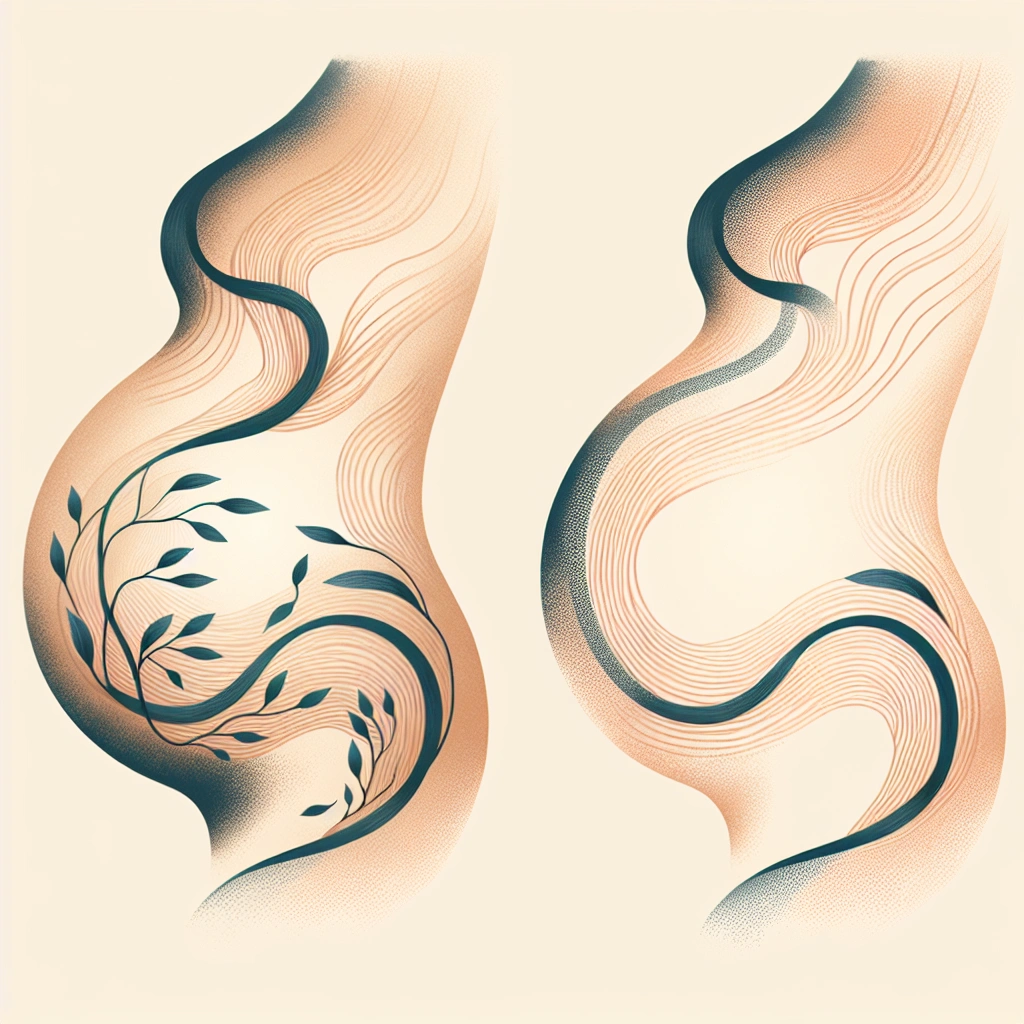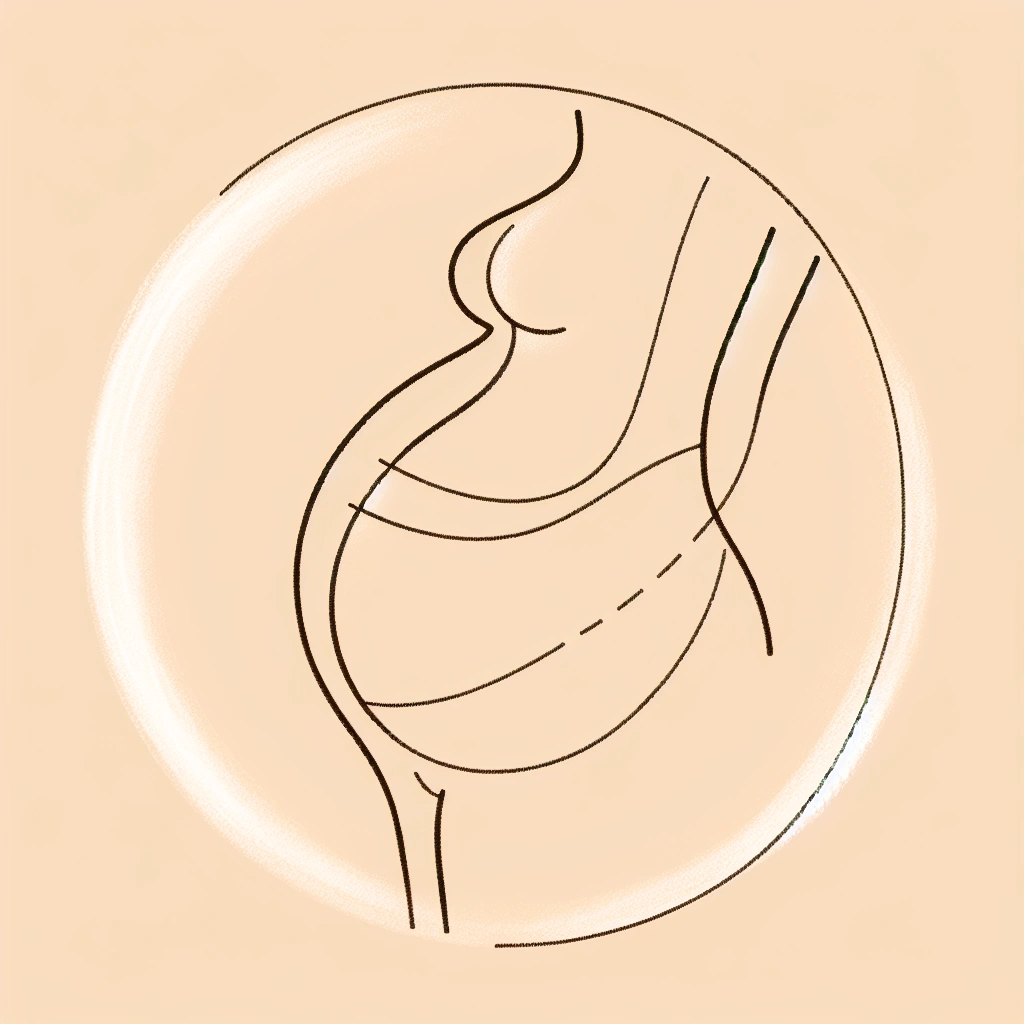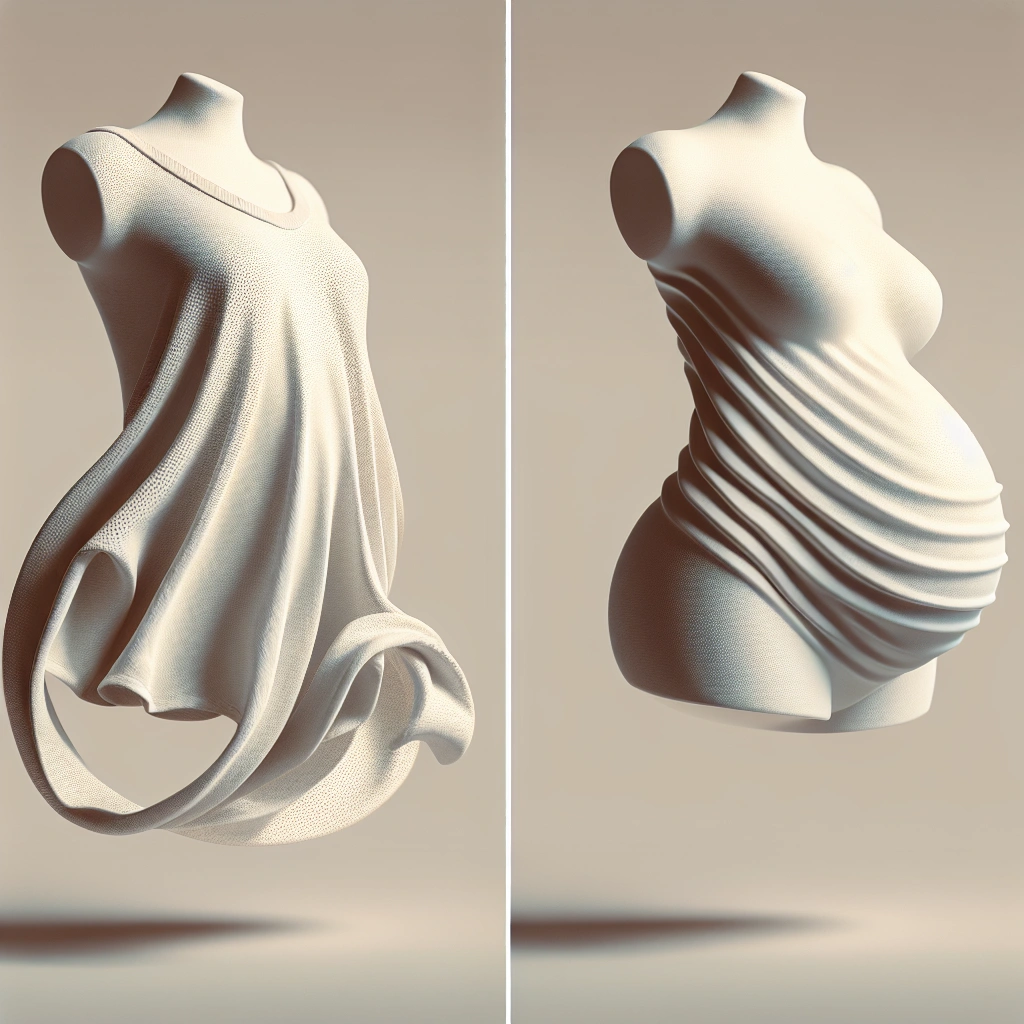Short Answer for What Happens to Existing Belly Fat When Pregnant
Existing belly fat does not disappear during pregnancy; instead, it stretches and adjusts to accommodate the growing fetus. This occurs because the skin and fat layer expand as the uterus enlarges for baby development.
Imagine, you’ve just discovered you’re embarking on the miraculous journey of pregnancy, already envisioning the sweet moments ahead. Yet, amidst this joy, a question lingers in your heart, “What happens to my existing belly fat when I’m pregnant?” It’s a concern shared by many, sparking a unique blend of curiosity and anxiety.
Pregnancy doesn’t make your belly fat vanish; it shifts, stretches, and accommodates the new life growing inside you. This transformation is not just physical but a profound reminder of your body’s resilience. Understanding this, let’s delve into how your pre-pregnancy belly fat responds to the intimate dance of gestation.
The balance between gestational weight gain and pre-existing belly fat is a delicate one, requiring attention and care. Whether you’re noticing your belly bump later or feeling the shifts in your body’s center of gravity, it’s all part of the process. Embrace this guide as your companion through these changes, offering insights and reassurance every step of the way.
-
Existing belly fat does not vanish during pregnancy; it stretches and adjusts to accommodate the growing baby.
-
The interaction between pre-pregnancy belly fat and gestational weight gain is crucial, requiring a balance to support a healthy pregnancy.
-
Weight gain during pregnancy is necessary for all women, regardless of existing belly fat, to ensure the baby receives adequate nutrients and support.
-
Pre-existing belly fat may delay the visibility of a pregnancy belly bump until possibly the third trimester, especially for women with more belly fat.
-
Pregnancy leads to a redistribution of body fat and a shift in the body’s center of gravity, affecting overall fat distribution and body mechanics.

Belly Fat and the First Trimester
During the first trimester of pregnancy, women experience hormonal adjustments such as increased levels of progesterone, which can slow the metabolism and potentially increase the storage of existing belly fat, and elevated estrogen levels that alter fat distribution, often making belly fat more pronounced initially. In addition to these hormonal changes, the body begins to redistribute adipose tissue towards vital areas for pregnancy, increasing total body fat, while also retaining more water, which can make existing belly fat appear more prominent. Furthermore, an increase in appetite can lead to additional fat storage if not carefully balanced with nutrition and exercise, making the management of belly fat during this period a multifaceted issue that involves hormonal, metabolic, and behavioral factors.
Hormonal adjustments and their impact on existing belly fat
During the first trimester of pregnancy, the body goes through incredible changes, folks, believe me. One of the most crucial aspects is the hormonal adjustments that significantly impact existing belly fat. Let’s break it down:
-
Increase in Progesterone: This hormone, folks, it’s fantastic, it prepares the uterus for pregnancy. However, it also can slow down your metabolism. This might lead to an increase in the storage of existing belly fat. For detailed insights, you can’t miss out on reading about the effects of progesterone.
-
Elevated Estrogen Levels: Estrogen is like the manager of fat distribution in women’s bodies. With pregnancy, it’s on the rise, and it influences where fat is stored, prioritizing areas like the hips and thighs, but initially, it might seem like it’s adding to your belly fat.
-
Human Chorionic Gonadotropin (hCG): This hormone, it’s a game-changer. While it’s known for its role in the positive pregnancy test, it also plays a part in metabolizing fat stores to provide nutrients to the developing fetus.
-
Increased Appetite: With all these hormonal changes, your appetite might go through the roof. This increased food intake can contribute to more fat storage if not balanced properly with nutrition and exercise.
Initial body changes and the redistribution of adipose tissue
The initial changes in the body and the redistribution of adipose tissue during the first trimester are subtle yet significant. Here’s what happens:
-
Adipose Tissue Redistribution: The body begins to redistribute fat, steering it towards vital areas needed for pregnancy support. Despite an increase in total body fat, this is a strategic move, ensuring the developing baby gets all the necessary nutrients. The process is explained brilliantly in this study on body fat distribution during pregnancy.
-
Increase in Total Body Water: Not everything that contributes to the size change is fat, believe me. The body also retains more water during pregnancy, which can make existing belly fat appear more prominent.
-
Weight Gain: It’s absolutely normal and healthy to gain some weight during pregnancy. However, the distribution of this weight gain isn’t uniform. In the first trimester, most women won’t see a significant bump, but the increase in body weight can accentuate existing belly fat.
-
Metabolic Rate Changes: As the pregnancy progresses, the metabolic rate adjusts. Initially, you might not see a dramatic increase, but the body becomes more efficient in fat storage to ensure energy reserves for the baby.
The first trimester is like the beginning of a beautiful, yet complex journey for your body. Hormonal adjustments and the initial changes in body composition have profound effects on existing belly fat. It’s important to remember that these changes are natural and essential for supporting the development of your baby. For those looking to understand more about these processes and how to manage them, diving into articles from reputable sources such as Appetite and food intake changes during pregnancy is a remarkable place to start. Remember, each woman’s body responds differently to pregnancy, and what you experience may differ from others. Stay informed, stay healthy, and embrace the incredible journey of pregnancy.
And let me tell you, embracing these changes with knowledge and understanding will not only benefit you but also your developing baby. It’s going to be tremendous, believe me.
| Hormone/Change | Effect | Outcome on Belly Fat |
|---|---|---|
| Increase in Progesterone | Slows down metabolism | May increase storage of existing belly fat |
| Elevated Estrogen Levels | Alters fat distribution, prioritizing hips and thighs | Initial increase in belly fat appearance |
| Human Chorionic Gonadotropin (hCG) | Metabolizes fat stores for fetus nutrients | May influence body fat composition |
| Increased Appetite | Leads to increased food intake | Can contribute to more fat storage if unbalanced |
| Adipose Tissue Redistribution | Redistributes fat towards vital areas for pregnancy | Strategic increase in total body fat |
| Increase in Total Body Water | Body retains more water | Makes existing belly fat appear more prominent |
| Weight Gain | Normal and healthy weight gain during pregnancy | Can accentuate existing belly fat |
| Metabolic Rate Changes | Metabolic rate adjusts, becoming more efficient in fat storage | Ensures energy reserves for baby, may affect belly fat |

What happens to existing belly fat when pregnant?
When pregnant, existing belly fat doesn’t disappear; instead, it stretches and adjusts to make room for the growing baby. The skin and fat layer expand as the uterus enlarges to accommodate the baby’s development, somewhat similar to preparing a foundation to support additional structures in a building project. This process, along with managing weight gain during pregnancy, is essential for both the mother’s and baby’s health, highlighting the importance of a balanced approach to pregnancy weight management.
Stretching and accommodation of growing belly
When you’re pregnant, believe me, fantastic things start happening, okay? Your body is like this incredible machine gearing up to support new life. Now, if you’ve got some existing belly fat when you find out you’re expecting, first of all, congratulations. Huge deal. But you might be wondering, “What’s going to happen to that belly fat?” Well, it doesn’t just vanish – I wish it did, but it doesn’t. Instead, it’s going to stretch and adjust to accommodate your growing baby. It’s like making room for a VIP guest in the best hotel. Everything gets moved around to make space.
For example, as your baby grows, your skin, along with the fat underneath, stretches out. This happens so your uterus can expand without any issues.
It’s kind of like when I’m making a huge, beautiful building. You need to make sure the foundations can support the extra stories you’re adding on top, right?
The interaction between pre-pregnancy belly fat and gestational weight gain
Now, let’s talk weight gain during pregnancy. Some people think, “Hey, I’ve got this extra belly fat, so I won’t need to gain much weight during pregnancy,” but that’s not how it works, folks. According to the pros, everybody – and I mean everybody – needs to gain some amount of weight to support a healthy pregnancy. It’s the body’s way of making sure the baby gets all the nutrients and support it needs, kind of like ensuring you have enough materials on site to finish that building project.
The interaction between your pre-pregnancy belly fat and gestational weight gain is like a delicate dance. They’ve got to work together harmoniously. If you gain too little weight, there’s a risk the baby might not grow as it should. On the flip side, if you gain too much weight, on top of the existing belly fat, it could lead to complications like gestational diabetes. It’s all about balance – something I know a lot about, believe me.
So, keeping track of your weight gain during pregnancy is crucial. Think of it like keeping an eye on the budget for a project.
You need to make sure everything is balanced for the best outcome.
Existing belly fat stretches and makes room for your baby, and managing weight gain during pregnancy is key. It’s a time to focus on health and balance, not only for you but for the little one growing inside you. It’s seriously huge, possibly the biggest project you’ll ever work on. And remember, consult your healthcare provider for personalized advice because, let’s face it, they’re the experts.

Belly Fat and the Second Trimester
In the second trimester, the visibility of a pregnant belly can vary significantly among women, especially in relation to pre-existing belly fat. Women with more belly fat may not see their baby bump become pronounced until the third trimester, as the added fat can conceal the growing uterus longer than in women with less belly fat. Conversely, those with less abdominal fat tend to show a visible baby bump earlier in the pregnancy, as there’s less cushion hiding the expanding uterus, making the pregnancy more visibly apparent sooner.
Visibility of belly bump in relation to pre-existing belly fat
Let’s talk about the visibility of the belly bump in the second trimester, especially for those fantastic ladies who’ve got a bit of extra cuddle around the middle before becoming pregnant. You know, it’s incredibly sensational but also a tad complicated. If you’ve got some pre-existing belly fat, here’s the deal: your burgeoning baby bump might play a bit of hide and seek with you. Isn’t that something?
For the women out there carrying extra fat tissue around the middle, your baby bump might not strut its stuff until the third trimester. This is a bit like waiting for the grand finale in a reality TV show – it takes time, but when it happens, boy, is it worth the wait! You can read more about this marvel at The Bump, where they dive deep into the stages of a pregnant belly’s development.
On the other hand, women with less belly fat might start to show earlier. It’s like being in the fast lane. The body frame and the amount of fat truly dictate the timeline. As detailed by Dr. Berios, “For first-time pregnancies, the baby bump may appear during the second trimester, at 12–16 weeks.”
Shifts in the body’s center of gravity affecting fat distribution
Now, onto the grand transformation of the body’s center of gravity. Imagine you’re drastically changing the composition of your magnificent body.
Pregnancy is essentially this awe-inspiring engineering feat happening right in the flesh. As weight is added primarily in the front, it’s a game of balance where the body’s center of gravity shifts forward.
This anterior shift is like recalibrating the whole system. Body mechanics evolve; there’s more pressure on the back, and dare I say, the distribution of fat gets a refresh too. You become a bit like a well-designed SUV, reconfigured for optimal performance with a new weight distribution. The details of this biomechanical wizardry are well articulated at Physio-pedia, explaining how pregnancy imposes mechanical stress on the body.
What we’re seeing here is a redistribution of resources. Existing belly fat might move around a bit to accommodate the baby bump. It’s not exactly a disappearing act, but more of a strategic relocation. Body composition changes are significant during pregnancy, involving fat mass and fat-free mass adjustments. This is fascinating stuff, almost like your body’s very own interior redesign project, outlined in detail here on this translated page that explores body composition changes Body composition changes in pregnancy.
The second trimester brings visible changes and a fascinating internal transformation. The way your body adapts and redistributes resources, including fat, to support the growing life inside of you is nothing short of magical. We might start with a certain amount of belly fat, but pregnancy is the ultimate remodel – altering not just the physical form but embarking on a deeply personal journey of growth and change.

Managing Belly Fat Through Healthy Practices
Managing belly fat effectively involves a combination of proper nutrition and regular exercise. Incorporating high-protein foods such as eggs, fish, legumes, and nuts, along with fiber-rich vegetables and whole grains, can combat belly fat by keeping you fuller for longer, reducing the urge to snack frequently. Safe and effective exercises, including walking, swimming, pilates, and yoga, not only enhance core strength and flexibility but also help in reducing fat accumulation by maintaining overall bodily health and wellness.
Nutritional needs and avoiding excessive weight gain
When we’re talking about managing belly fat, especially when you’re expecting, let me tell you-nutrition is key. You’ve got to eat right.
It’s tremendous, really. So, here’s the deal:
-
Protein is your friend. Let me be clear, amazing sources include eggs, fish, legumes, and nuts. These foods don’t just sit there; they work for you, fighting off belly fat like nobody’s business. Read more about the impact of a high-protein diet on abdominal fat here.
-
Fiber? Huge.
Adding fiber-rich foods like vegetables and whole grains will fill you up faster, so you’re not going after snacks every five minutes. It’s about being full and satisfied, folks.
Safe exercises to maintain core strength and mitigate fat accumulation
Now, let’s get moving. Because let’s face it, a great diet without exercise is like a car without gas.
It’s not going anywhere.
-
Walking. It’s simple, it’s effective, and guess what? It works. Walking burns fat, keeps you active, and hey, it’s free.
-
Swimming. Folks, swimming is phenomenal. It’s low-impact, it’s cardio, and it’s refreshing. It works your whole body without putting strain on your belly.
-
Pilates and Yoga. Great for flexibility, great for core strength, and great for your mind. And in times like these, who doesn’t need a little peace of mind?
So, that’s the rundown. Eat right and move more. It’s not rocket science, but it is science, and it works. Keep your nutrition on point – protein and fiber, remember? And mix in those safe exercises – walking, swimming, Pilates, and yoga.
And you know what? You’re going to do great.
Because managing belly fat through healthy practices isn’t just good for you; it’s good for the amazing little person you’re bringing into this world. Stay healthy, stay happy, and let’s make belly fat management great again.

Conclusion
During the first trimester of pregnancy, hormonal adjustments lead to significant changes in existing belly fat, primarily through an increased storage facilitated by a slow metabolism caused by elevated progesterone levels. This phase also witnesses a redistribution of adipose tissue, aiming to prioritize the health and development of the fetus, while increased body water and weight can make belly fat more pronounced.
As the pregnancy progresses into the second trimester, the visibility of the belly bump might vary based on pre-existing belly fat, with those having more belly fat possibly showing a bump later than those with less. This period also showcases a fascinating shift in the body’s center of gravity and fat distribution, accommodating the growing fetus and maintaining balance.
Existing belly fat when pregnant undergoes stretching and accommodation to make way for the growing baby, interacts with gestational weight gain in a balancing act critical for a healthy pregnancy, and sees a visible and structural transformation especially noted in the second trimester. These changes highlight the body’s remarkable ability to adapt and support new life.
